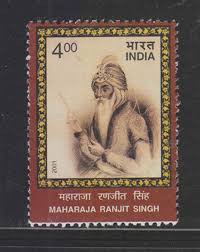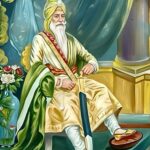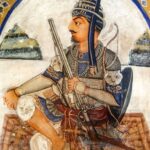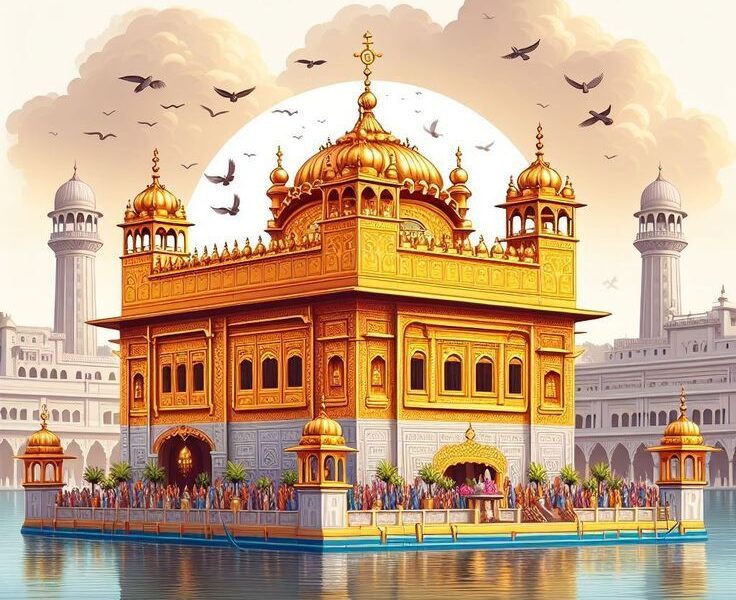The 18th century was coming to the end when a so-called rule of Shah Alam II existed in India. The prime time of the Mughal sultanate had ended and the advent of the Britishers in India was on. In this background, 12 independent tribes or clans of the Sikhs had inhabi ted Punjab, the land of five rivers. Every Sikh tribe was called ‘misl’ that had its own Sardar (chief) and the army. The ‘misls’ had intra fighting but they unitedly faced the attack when it was from outside. Their united army was called ‘ Dal Khalsa.’ The ‘misl’ of Gujranwala kept the largest army called ‘Shakar Chuckya misl.’
The number of fighters in that army was stated to be up to 15000. But in 1792 a 12-year-old boy was made Sardar of this ‘misl.’ He was the only son of his father so he not only became sardar of Shakar Chukcya but the overall ‘Khalsa.’ The boy had two major enemies. One were the Afghans in the West and the other was Britishers of the East India Company. Apart of them his own Sikh community posed as a third rival to him. Born in today’s Pakistan city, Gujranwala he was known by the name of Punjab Maharaja, Ranjit Singh. I am Faisal Warriach and I will show the tale of this Sikh Maharaja in ‘Wo Kon Tha’ series of Dekho, Suno, Jano. Lahore was being ruled by ‘Bhangi’ sardars in 1799. Capturing Lahore from Bhangis was easy, yet threat lay from Afghan successors of Ahmad Shah Abdali. Why? Ahmad Shah and his successors had taken control over Lahore since the Mughal rule in India became weak.
The Afghans detested occupation of their land by others hence they attacked the occupants. Therefore the grandson of Abdali, Shah Zaman returned to Lahore when Bhangis captured this City. He easily captured Lahore. Here Zaman wanted to have a decisive battle with Sikhs but he rushed to Kabul where situation was not normal. He left his representative in Lahore and went back to Afghanistan to save his rule. But on his way back he faced a problem. That he was to cross over the river Jehlum which then was in surge and flowing fast. So a number of costly cannons of Zaman sank into the water while crossing the river.
The cannons were a vital weapon of war at that time. They played the same fatal role in the battles as do the missiles in the present era. This was a big loss which needed to be regained. But for that Shah Zaman needed to stay there and wait till the river water would wane. But he did not have time for it. But these cannons were much valuable for him that he was ready to pay any cost to recover them. Even he could have pay the cost of Lahore for them. In this situation, Zaman reached an agreement with his enemy, Ranjit Singh. That if Ranjit sent back the cannons to him in Afghanistan, he would accept his rule in Lahore. It meant, Shah Zaman would not attack Lahore to capture it. He had also learned about the inefficiency of his representative and Bhangis’ attempt to recapture Lahore Lahore also needed a friendly ruler in Afghanistan to avoid att acks from that part. This offer was acceptable to Ranjit Singh. So he pulled out eight guns from the river and sent them to Peshawar; then subject to the Afghan Sultanate. There was a fort called ‘Bala Khasar’ in the center of Peshawar that Ahmad Shah Durrani had made use of. These days it houses the headquarters of the Frontier Corp.
Although Ranjit Singh had joined hand with Afghanistan yet rule of Lahore was not possible without capturing it. On the other hand the Lahorites were also concerned at the absence of a permanent government. The incompetent Bhangis had intra fights which mad life and property of the people insecure. In this situation the people badly missed a powerful, local and permanent ruler for them. In the mind of some superiors, it was Ranjit Singh capable of filling this void. So a contact was made to Ranjit Singh. It goes that including Muslims many important persons wrote to Ranjit Singh for taking Lahore under his control. Ranjit Singh was also waiting for this opportunity. The mother-in-law of Ranjit Singh, who was a strong lady, also came to his support. Where his mother-in-law has come from all of a sudden? The story goes that Ranjit Singh was married in the ‘Kanhaiya misl’, that was a a quite strong tribe. His mother-in-law Sada Kaur called the shots in the ‘misl’. Sada Kaur was also aware of the hardships of the people of Lahore. She also knew about the letters sent to Ranjit Singh by the Lahore inhabitants. She was a wise lady who pursuaded Ranjit Singh to rule Lahore which meant ruling the whole of Punjab. Because history teaches that who rules Lahore, rules the Punjab. Ranjit Singh got the point. So he sent spies to Lahore. The powerful peaple of Lahore, pariculary Muslims, who were opposed to Bhangis, sided with Ranjit Singh. They promised Ranjit Singh of opening the City gates. So when Ranjit Singh proceeded to Lahore, two of the three Bhangi sardars fled the City. The third Sardar Chit Singh took position inside the City. But those who were in collusion with Ranjit Singh opened gates of the City. In this situation Chit Singh with 500 soldiers holding swords got stationed in Hazoori Bagh. It is the same Hazoori Bagh which lies between the Badshahi Mosque and the Lahore Fort. Obviously, fight was out of question now. So Chit Singh laid down the arms. Ranjit Singh pardoned Chit’s life and banished him with his family from the City. Thus Lahore fell to Ranjit Singh without any bloodshed in 1799. The victory of Lahore was a turning point for Ranjit Singh as it laid the foundations of a vast Sikh Sultanate. His son Kharak Singh was also born in Lahore after two years of this victory. Kharak Singh’s birth was celebrated for 40 days while Ranjit Singh assumed the title of Maharaja on Besakhi.
A formal coronation was held and foundation of the first Sikh Sultanate in Punjab was laid. Now Ranjit was no more a sardar of Shakar Chachya but a Maharaja poised to expand his rule to outside Lahore. It had become hard to stop advancements of Raja Ranjit Singh. Now one after the other every fiefdom was becoming his tributary. Every fiefdom was bound to pay tax to Ranjit Singh. After Lahore, Jammu, Nurpur, Chiniot, and Jhang became part of Ranjit Singh’s Raj. By 1803, his Raj (rule) had reached up to Rawalpindi. Now from Lahore up to Rawalpindi all feudal lords were his vassal. Now he wanted a cannon or gun to mark the glory of his rule. This cannon was the zamzama (Kim’s gun). In 1805, he demanded the Bhangis of Amratsar to hand over their gun Zamzama in honour of the promise… they had made with his grand father. The Bhangis had yet not got Lahore defeat out of their mind. So they declined and Ranjit Singh attacked Amratsar. Earlier, the Bhangis had failed to check Ranjit in Lahore but their position in Amratsar was even more delicate. Ranjit Singh conquered the City in two hours. And the Zamzama is today placed on a road outside the Lahore Museum and in front of the Punjab University. It is open to general public view. Ranjit’s conquest of Amratsar shocked the Britishers who had by that, captured almost the whole of India. Now the Britishers faced two-way difficulty. One was a strong Sikh state on their West while the other from their arch enemy French Emperor… Napoleon Bonaparte who could turn to India anytime and Ranjit Singh might become his ally against them. The same threat the Britishers had faced while fighting Tipu Sultan a few years ago. Therefore they found the solution in striking an agreement. This agreement reached in 1809 was called ‘Amratsar agreement. As per the spirit of this agreement, the Britishers would accept domination of Ranjit Singh across River Sutlej. And Ranjit Singh would not create any difficulty for them to the other side of the river on the eastern side. The agreement also required Ranjit Singh to help the Britishers if Napoleon would attack India. In other words, Ranjit Singh would not be an ally of Napoleon but that of the Britishers. The agreement rendered Punjab as buffer zone for the Britishers which meant a strategic depth for… the Company’s government as Ranjit Singh was to face first any attack from Afghans or the French. Ranjit Singh got the benefit of including the areas between river Sutlej and river Sind in his domain. Ranjit had captured some of its areas, some were his tributaries and some others accepted his rule.
This all gave of sense of power to Ranjit Singh. But there was another element that could double this feeling but it was missing with him. It was a such that anyone holding it could be regarded as the strongest ruler in the world. It had a symbolic value for power. It was the Koh-i-Noor. The largest diamond in the world. The Koh-i-Noor was taken away by Iranian ruler Nadir Shah from the Mughal Emperor, Rangeela Shah. From Nadir the Koh-i-Noor came to his General Ahmad Shah Abdali who also ruled Afghanistan. After shifting many hands, this diamond reached his grandson Shah Shuja. Shah Shuja was holding power in the Kandahar province. But his adversaries dethroned him. But he somehow managed to reach the prison-like protection of Ranjit Singh. Ranjit Singh soon came to know that Shah Shuja was holding the Koh-i-Noor . But Ranjit did not know where Koh-i-Noor lay? Only Shah Shuja knew where Koh-i-Noor was lying. Ranjit Singh could not secure the Koh-i-Noor by killing or through torture on Shah Shuja. As by that he might have turned Shuja’s supporters in Afghanistan against him. He feared an adverse situation for him in case Shuja’s supporters would to come to power in Afghanistan. Moreover, Shah Shuja was also ally of the Britishers. In nutshell, using force on Shah Shuja was out of question. And Shah Shuja was not ready to give the Koh-i-Noor to Ranjit Singh easily. At some distance from Mochi Gate Lahore, a haveli called Mubarak Haveli is situated. The well-known Nisar Haveli, from where Moharram processions appear, is also housed in that Haveli. In Mubarak Heveli, Shah Shuja and his family members were detained or were kept as guests. So in order to get the Koh-i-Noor, Ranjit Singh blocked the movements to this Heveli in 1813 Whereby neither Shah Shuja and his family could come out nor they get any eatable from outside. They were the hot days of May inside the walled city. The rulers of the past were passing through the most oppressive days of their life. The plight of Shah Shuja’s children became miserable due to weather heat and hunger. In this situation he sent a message to Ranjit Singh. In the message he expressed willingness to give the Koh-i-Noor provided Ranjit Singh would himself see him. That the Koh-i-Noor would not be sent to him through anyone.
Ranjit Singh got ready to see him and their dialogue in the meeting became a history. Ranjit Singh came to Shah Shuja and became highly delighted after getting the Koh-i-Noor from him. He asked Shah Shuja about price of this diamond. Shah Shuja replied: “Power is its price. We wrested it from the Mughals through power. Then another powerful took it away from us and whoever is more powerful will snatch it from you.” It was an irony that the same happened later on. Shah Shuja was displeased with Ranjit Singh for the bad behaviour . Shah Shuja was so much depressed by it that he planned escape. First of all he took his women out of the Haveli one by one and sent them to Ludhiana. Ranjit Singh came to know that Shuja family was slipping out, he doubled the watch on them. But Shah Shuja was young and smart. So got some loyalists to his help. One night he shifted many rooms and made a loyalist sleep on his bed and escaped in the guise of a beggar. But it was difficult for him to go out the City. All City doors had been shut down and the guards were deployed there. Therefore Shah Durrani jumped into a drain channel that led to outside the City. Do you know you where from he got out? It was Mori Gate. He was smeared with dirt when came out of the drain. Whether it is true or false but it goes in history when Shuja looked back at the City on this occasion… he uttered lines that spelled out duplicity of the Lahorites that made him pass through the drain. Rendering: “Lahorites make much of the showoff but they lack true love. They show the open doors but give the exist through secret doors”. We are not sure whether Shah Shuja had learned Punjabi or it was Punjabi translation of what he said in Pushto. Albeit after finding exit from Mori Gate, he reached Data Darbar. Here he washed himself and changed and left for Ludhiana to his family. It was 1816 when this banished Kandahari was only 29. In Ludhiana, Shah Shuja gave himself to the protection of the Britishers after some time. He wanted to regain power in Afghanistan and for it he needed help of the Britishers or Ranjit Singh. At that time, the Afghan chiefs claimed their domination over the area up to the Indus river. This area also included Peshawar and the tribal areas, that is called FATA in the present day Pakistan. Ranjit Singh was also interested in expanding his Sultanate beyond the Indus. Therefore he attacked Peshawar in 1818. The rulers left Peshawar without any resistance and took position in the passes on the mountains. Although Ranjit Singh had captured Peshawar but retaining its possession was a matter.
Because attacks by the Afghans and the tribes were constant and intense. The Pathans did not accept the Sikh rule in Peshawar. Therefore, the Afghans and the Pathans were preparing armies for attack on the Sikh. One of such armies was raised by Tehrike Mujahideen under the command of Syed Ahmad Shaheed. This army faced the Sikh army at Bajour and defeated the rivals. Syed Ahmad Shaheed also established his rule in Peshawar in 1831. Now the army of Syed Ahmad also became a big challenge for Ranjit Singh like Afghan chiefs. But in this scenario many Pathans and important tribal cheifs turned against Syed Ahmad . The reason being, Syed Ahmad had assumed the title of Caliph and Ameer. Some Pathans also feared end to their chieftainship in case Syed Ahmad’s movement would succeed. Therefore they withdrew their support from Syed Ahmad’s Tehrike Mujahideen. They stopped donations to the Tehrik, then began to gather reports of its members and finally attacked them. In order to take stock of this whole situation,Syed Ahmad called a meeting of his fighters at Balakot. Syed Ahmad wanted to move to Kashmir and organize the Mujahideen. In 1831 Ranjit Singh’s son, Sher Singh leading a big army, surrounded him at Balokot. The Sikhs had come well-prepared and were large in number. Despite that, it was not an easy fight. The adherents of Syed Ahmad and the Sikh had a pitched battle. In this battle, Syed Ahmad and his disciple Shah Ismael were martyred. Their graves still exist in Balakot. Hence Ranjit Singh got rid of the threats from the frontier areas. It is stated that Ranjit Singh became angry on learning that his sons had killed Syed Ahmad and Shah Ismeal. Because he revered the status of ‘Syeds’ among Muslims. He told his sons, “you killed Syeds, so no escape for us now.” The conquests of Maharaja Ranjit Singh continued till the end of his life. 3 years before his death, he annexed Dera Ghazi Khan, Dera Ismael Khan, Tank, and Bannu to his Sultanate. During the same period, Sikhs also got settled in Kyber PK in a large of number and were still there. During the same period, the French emperor Napoleon Bonaparte suffered a historic defeat in Waterloo. A well known General of the Napoleon army Ventura, came to Punjab after Waterloo war. He took the service with Raja Ranjit Singh. At the Lower Mall Lahore Civil Secretariat is situated. One would have rarely thought this building… was not built by the Britishers but during the era of Ranjit Singh by the French for their own use. This building was the residence of French General Jean Farncois Allard. General Allard was the trainer of Ranjit Singh army and was so strict in his job that many wanted to escape. It is known about him that he shot dead a Sikh soldier when he broke into tears during the training. General Allard said this man was a shame on the Sikh army. The army under the command of the French generals was not an ordinary one but elite force of the Maharaja. The graves of General Allard and his daughter Marrie Charlotte still exist at Munshi Chambers Lahore.
It also goes about Maharaja Ranjit Singh that he had conquered Kabul. But it is not true. The Britishers had conquered Kabul in 1839 where they had enthroned Shah Shuja to rule. However it was a fact the Ranjit Singh had helped them in honour of an agreement. But when the Sultanate of Ranjit Singh was at its prime, a big loss came to him. It was the death of General Hari Singh, who had helped him get Sialkot, Kasur, Multan, Kashmir and Peshawar. General Hari Singh Nalva is also known for defeating the Afghans. His monument stands in Haripur, Pakistan. Hari snatched Kashmir and present Khyber PK from the Afghans and drove them to the current Afghan borders. The current border between Afghanistan and Pakistan that is called Durand Line… in fact, goes through the same areas which General Hari had conquered after pushing back the Afghans. The Sikhs had taken away these areas from Durrani Sultanate of Afghanistan. Officially Afghanistan todate does not acknowledge the Durand Line as border. We told you in the 2nd episode of ‘History of Pakistan’ that Afghanistan did not accept creation of Pakistan It was because of the same disputed boundary between the two countries. It was despite the fact the 200 years had passed since these areas were separated from Afghanistan. And in the past many areas of them had never been under the permanent control of Afghanistan. Before going into the temporary control of the Afghans, these areas were under the Mughal Sultanate. The Mughal Sultanate in India long remained expanded to the Center of Afghanistan, Kabul. This information aim at highlighting how important a General was Hari Singh Nalva for Ranjit Singh. Ranjit Singh was grieved over his death but more painful for him was the fact he did not die in any major battle. Rather he had lost his life in a petty clash wherein he might have easily save himself. The story of his death goes that the Afghans attacked an area near Khyber Agency of the present Pakistan. Here Gen Nalva was constructing a fort when all of a sudden he faced a small group of the Afghan army. This group was quite small yet the number of soldiers with Hari Singh was lesser than the Afghans. As a consequent of it, General Hari Singh and his soldiers all were killed in that clash. Despite that the Afghans failed to get hold of the fort. Ranjit Singh was also losing other army generals in the battles. Because battles were still going on. In this situation Ranjit Singh was also not taking much care of his health. Over-drinking and unabated spate of battles had badly affected his health after 1830.
At a night in the rainy season in 1835, he suffered a stroke which paralised right side of his body. The stroke was intense that took away his power to speak. He was no more articulate in his speech. Despite all that he continued to hold Court (darbar) in Lahore. After one and a half years he again suffered a paralyse attack that made him bed ridden. Next year he suffered another paralyse attack. This attack rendered Ranjit Singh absolutely dumb. Everyone was apprehensive about the life of Maharaja Ranjit Singh. The Britishers also offered to provide him medical treatment but Ranjit Singh did not accept it. And Ranjit Singh continued to get treatment for his minister, close aide and physician Faqir Azizuddin. Alms and bestowment were given at the last stage of his life amid vanishing hopes. Elephants, horses, statues of gold and silver were given away. In order to please the gods, even animal slaughtering was banned across Punjab. But nothing could save his life and Ranjit Singh died on June 27, 1839. His last rites were held at the place between Minara Pakistan and Lahore Fort where his Tomb stands today. Ranjit Singh’s four wives and seven maids announced to immolate themselves on his pyre.
Then ‘Satti’ ritual was carried out in India that meant self-immolation of the widow on her husband’s death. During the British rule in India this rite was banned. Before the last rites his body was perfumed and the royal robe was put on. The Ranis who had announced ‘Satti’ (immolation), were leading his funeral procession. His body was put on the sandalwoods. The four Ranis and the seven maids sat on the pyre. Ranjit Singh’s head was on the lap of a Rani when Kharak Singh put a sheet soaked in purified oil put on them all. Then the pyre was set on fire. On the fourth day, the ashes and bones of the Maharaja were sent for releasing into River Ganga. The Sultanate of Ranjit Singh spread from Lahore to Sindh and from China, Afghanistan up to Delhi. His successors were not capable enough to sustain such a large empire. As per Ranjit Singh’s will, his son Kharak Singh became the Raja but the empire was on the decline now. Ranjit’s sons came to the throne one after the other but downfall of the empire continued. Then the Sikhs fought with the Britishers in 1845 and 1848.
The battle in 1848 ended up at the occupation of Lahore by the East India Company. Thus the last autonomous Sultanate in India also went into the hand of the Britishers. Last time, 10-year-old son of Ranjit Singh, Dalip Singh was ruling Lahore. The Britishers sent Dalip Singh to London where he presented Koh-i-Noor diamond to Queen Victoria. And it proved true the historic prophesy of Shah Shuja. Dalip gifted the Koh-i-Noor to the Queen terming it in return of the Britishers’ help to the Sikh in battles. 105-karat heavy Koh-i-Noor is still studded in the Crown of the Queen and preserved in the Tower of London. Pakistan and India both lay claim on this diamond. The citizens of both the countries also took to law to get back the diamond, but no outcome of their cases so far. Besides the Koh-i-Noor, the Brithers also transported many other valuables from India to Britain.
Just assess the amount of these valuables from a necklace the Queen had prepared with Indian diamonds. Called ‘Coronation Necklace’ it the most expensive diamond necklace of the time. The central diomond of the necklace was named “Lahore Diamond.” This necklace is still under the use of the British Royal family. Dalip Singh stayed in Britain for some years during which he got education besides getting stipend. On growing up, Dalip Singh however turned against the Britishers. He made bid to regain his throne with the help of Russia. But he failed. He become impoverished and went to Paris where he died in 1893. So the last claimant to the Sikh Sultanate in Punjab also passed away. A motion picture titled ‘ the Black Prince’ was also produced on his life.
The story of Ranjit is the story of Punjab and the story of Lahore. It goes that the biographies procure the most precious lessons of life. Click here if you are interested in knowing about the life of the unforgettable characters of the history. Click here to know detailed and true story of Kargil war and here to know how China became the world power?








